This is a timeline of the history of Korea. Some dates prior to the 5th century are speculative or approximate.
Three Kingdoms
- 42: Traditional date for the founding of Gaya by Suro.
- 53: Goguryeo becomes a centralized kingdom under Taejo's reign.
- 234: Baekje becomes a centralized kingdom under Goi's reign.
- 313: Goguryeo destroys Lelang commandery.
- 356: Silla becomes a centralized kingdom under Naemul's reign.
- 371: Baekje's King Geunchogo invades Goguryeo and kills King Gogugwon.
- 372: Under Sosurim, Goguryeo imports Buddhism from Former Qin of China.
- 384: Chimnyu of Baekje officially adopts Buddhism.
- 392: Gwanggaeto the Great of Goguryeo begins his reign, expanding Goguryeo into a major regional power.
- 413: Jangsu of Goguryeo erects the Gwanggaeto Stele.
- 433: Baekje and Silla form an alliance against Goguryeo's aggression.
- 475: Goguryeo attacks Baekje and captures Hanseong (modern day Seoul). Baekje moves its capital south to Ungjin (modern day Gongju), and again to Sabi (modern day Buyeo) in 523.
- 494: Last remains of Buyeo absorbed by Goguryeo.
- 498: Baekje attacks Tamna (modern day Jejudo).
- 512: Silla conquers Usan (modern day Ulleungdo).
- 527: Silla formally adopts Buddhism
- 553: Silla attacks Baekje, breaking the alliance.
- 562: Silla completes annexation of Gaya.
- 598: First of a series of major Sui Dynasty attacks in the Goguryeo-Sui Wars, which ends in 614 in a costly defeat for Sui.
- 612: Goguryeo repulses second Sui invasion at the Salsu.
- 645: First campaign in the Goguryeo–Tang War.
- 648: Silla establishes alliance with Tang.
- 660: Baekje falls to the Silla-Tang forces.
- 668: Goguryeo falls to the Silla-Tang forces.
North South States Period and Later Three Kingdoms
- 676: Silla repels Chinese alliance forces from Korean peninsula, completes unification of much of the Three Kingdoms.
- 698: The founding of Balhae by former Goguryeo general Dae Joyeong.
- 751: Silla, at its cultural peak, constructs Seokguram and Bulguksa.
- 828: Jang Bogo establishes Cheonghaejin, a major center of trade with China, Japan, and Vietnam.
- 892: Silla begins to lose control of parts of the peninsula as the brief Later Three Kingdoms period begins.
- 900: Hubaekje ("Later Baekje") established in the southwest of the peninsula.
- 901: Taebong ("Later Goguryeo") established in the northwest of the peninsula.
- 918: Founding of Goryeo by Taejo of Goryeo.
- 926: Balhae falls to Khitan forces.
- 935: Silla formally surrenders to Goryeo.
- 936: Hubaekje formally surrenders to Goryeo.
Goryeo
- 936: Goryeo completes the reunification of the Later Three Kingdoms, absorbing the of Hubaekje and parts of former Balhae territory.
- 956: Emperor Gwangjong forces major land and slavery reforms, and in 958 implements civil service examinations.
- 993: The first of three Goryeo-Khitan Wars.
- 1010: The Second Goryeo-Khitan War ravages the northern border.
- 1018: The Third Goryeo-Khitan War, Khitan successfully repelled.
- 1033: Goryeo builds the Cheonri Jangseong (lit. "Thousand Li Wall"), a massive wall running along the northern border.
- 1145: Kim Bu-sik compiles the Samguk Sagi, Korea's oldest extant history text.
- 1170: The military coup.
- 1231: The Mongol invasions of Korea begin.
- 1234: Choi Yun-ui's Sangjeong Gogeum Yemun is published, world's first metal-block printed text.
- 1251: Goryeo completes the Tripitaka Koreana, the most comprehensive and oldest intact version of the Buddhist canon in Chinese script.
- 1268: Mongol peace treaty is signed which Mongols agree to protect them the best they can.
- 1270: Goryeo signs a peace treaty with the Mongols, beginning an 80-year period of Yuan overlordship. The Sambyeolcho Rebellion lasts for three more years.
- 1285: Il-yeon compiles the Samguk Yusa, record of history and legends.
- 1388: General Yi Seonggye, ordered to engage China in a border dispute, turns his troops against the Goryeo court.
Division of Korea
- 1945: After the surrender of Japan, the Korean peninsula is divided between Soviet and American occupation forces at the 38th parallel.
- 1945: South Korea created a franchise to raise money and funds to recover.
- 1945: 6 September, Establishment of Peoples Republic of Korea with Yuh Woon-Hyung, but 1946 February, US Army breaks it and Yuh Woon Hyung is murdered.
- 1946: US-USSR Joint-Commission on the formation of a Korean Government reaches an impasse. The Joint-commission is dissolved as the Cold War begins.
- 1948: 10 May. UN sponsored elections are held in South Korea.
- 1948: 15 August. Establishment of the Republic of Korea with Syngman Rhee as President.
- 1948: 9 September. Establishment of the Democratic People's Republic of Korea with Kim Il-sung as Premier.
- 1949: The murder of Kim Gu. Kim Gu was a Korean independence activist who believed in, and fought for, a unified Korea. He strongly objected to the formation of a separate South Korean state. He was shot in his home by a South Korean Army lieutenant.
- 1950: 25 June. The Korean War begins.
- 1950: August. UN Forces are driven back to South-east corner of the Korean Peninsula (The Pusan Perimeter).
- 1950: September. UN Troops make an Amphibious Landing at Inchon.
- 1950: November. Chinese Forces enter the war
- 1953: The Korean War is halted by the Korean Armistice Agreement that has remained in force until now.
- 1960: A student uprising begins the April Revolution which overthrows the autocratic First Republic of South Korea. Syngman Rhee resigns and goes into exile.
- 1961: 16 May. Military forces, headed by General Park Chung Hee, overthrow the Second Republic of South Korea in what is known as the Military Coup d'état of 16 May
- 1961: 12 November. Summit conference for normalization of Kor-Japanese relations
- 1962: start of the first Five-year plans of South Korea
- 1964: South Korea joined Vietnam War
- 1965: 22 June. Signing of Treaty on Basic Relations between Japan and the Republic of Korea. Earned both much controversy and procurement of budgets for later economic developments.
- 1967: start of the second Five-year plans of South Korea
- 1968: 21 January. An unsuccessful attempt of North Korean commandos to assassinate president Park Chung Hee- the Blue House Raid.
- 1968: 1 April. Establishment of the Pohang Iron and Steel Company
- 1968: 5 December. Proclamation of the National Education Charter
- 1970: 22 April. Start of the government-operated New Community Movement
- 1970: Gyeongbu Expressway is completed and opened to traffic.
- 1972: start of the third Five-year plans of South Korea
- 1972: 12 August. The first Red Cross talks between North and South Korea are held.
- 1972: President Park Chung Hee declares Emergency Martial Law and changes Constitution in August, which may allow him to become the permanent ruler. This is similar to Gojong of the Korean Empire stating his country's governmental system as 'autocratic' in the constitution- for greater leadership and less opposition.
- 1974: 15 August. Assassination of first lady Yuk Young-soo by self-proclaimed North Korean Mun Segwang.
- 1976: 18 August. The Axe Murder Incident in Panmunjom, Joint Security Area. Triggers former North Korean leader Kim il-sung's first official apology to the South.
- 1976: 12 October: Discontinuation of rice imports, accomplishment of total self-sufficiency in rice by the 'Unification Rice'
- 1977: start of the fourth Five-year plans of South Korea
- 1977: 22 December. Celebration of achievement of 10 billion dollars gained by exports.
- 1978: 26 October. Detection of 3rd underground tunnel. Made by North Korea to attack South Korea.
- 1978: 10 December. Achievement of 1,117 US dollars as GNP.
- 1979: American president Jimmy Carter visits Korea. Threatens Park by stating he would reduce the US forces in Korea if he does not stop the ongoing Nuclear Weapons Development project.
- 1979: 26 October, President Park Chung Hee is assassinated by chief of KCIA, Kim Jaegyu (Assassination of Park Chung Hee).
- 1979: Coup d'état of December Twelfth, Chun Doo Hwan gets military power
- 1980: Gwangju massacre. Martial Law is declared throughout the nation. The city of Gwangju becomes a battleground between dissenters and the Armed Forces (18–27 May). The official death toll was set at 200 people but some reports claim over 1000 casualties.
- 1987: A student uprising begins the June Democracy Movement, which overthrows the autocratic Fifth Republic of South Korea. The ruling party of Fifth Republic, Democratic Justice Party, declares democratic elections.
- 1988: 24th Olympic Games held in Seoul
- 1990: 11 September: South Korea and the USSR establish diplomatic relations.
- 1991: 17 September: North Korea (DPRK) and South Korea (ROK) join the United Nations (UN).
- 1991: 26 December: The end of the Cold War as the Soviet Union ceased to exist and North Korea loses military and economic aid.
- 1992: 11 August: South Korea's first satellite, KITSAT-1, a.k.a. 우리별 (Uri Byol) is successfully launched from Guiana Space Centre.
- 1992: 24 August: South Korea and the People's Republic of China (PRC) establish diplomatic relations.
- 1993: Test of Rodong-1, a single stage, mobile liquid propellant medium range ballistic missile by the DPRK.
- 1994: Kim Jong Il takes control of North Korea upon the death of his father Kim Il-Sung. Start of the Arduous March.
- 1998: Taepodong-1, a two-stage intermediate-range ballistic missile is developed and tested by the DPRK. End of the Arduous March. It is possible that up to 3.5 million people did not survive the 'march'.
- 1999: The DPRK promises to freeze long-range missile tests.
- 2002: The 2002 FIFA World Cup jointly held by Korea & Japan. South Korea national football team makes it to the semi-finals for the first time in Korean football history. The DPRK pledges to extend moratorium on missile tests beyond 2003.
- 2004: The DPRK reaffirms moratorium.
- 2005: The DPRK fires short-range missile into the East Sea.
- 2006: Test of Taepodong-2 by DPRK, a successor of Taepodong-1.There is a nuclear test in the DPRK. US officials assert it might have been a misfire.
- 2007: The second summit between DPRK and ROK leaders is held, with Roh Moo-hyun representing the south and Kim Jong Il the north. The DPRK fires short-range missile into the East Sea.
- 2009: North Korea launches a rocket (Unha), supposedly for space exploration. This move affects relationships with Japan, the United States and South Korea. The DPRK conducts another nuclear test.
- 2010: North Korea launches missile and attacks Korean Pohang class corvette, ROKS Cheonan. 46 Korean soldiers die because of the attack. At November, North Korean army rains artillery fire on Yeon-Pyeong-Do island.
- 2011: Kim Jong Il dies, Kim Jong un takes over as the Supreme Leader of North Korea. The National Intelligence Service discovers Communist spies who have been working underground for the DPRK for almost 10 years. One of the members was a former Democratic Party representative. Their mission was to influence the party named above and extract military secret information.
- 2012: 13 April: The Kim Regime of the DPRK tested a rocket, officially called "Unha-3", an expendable launch system developed from the Soviet Scud rockets. The rocket was to send a satellite, called "Kwangmyŏngsŏng-3", into orbit. The rocket failed to launch the satellite and fell into the Yellow Sea. The mission ultimately ended in complete failure.
- 2012: 12 December: DPRK has successful launch of Kwangmyŏngsŏng-3 Unit 2 it was launched from the Sohae Satellite Launching Ground. A South Korean military official cited 3 stage success. DPRK confirmed.
- 2012: 19 December: Park Geun-hye, a daughter of Park Chung-hee, is elected as first female and the 11th president of South Korea.
- 2013: 8 December: Jang Song Thaek, uncle of North Korean Leader Kim Jong Un, was ousted from all powerful posts on various charges. The official Korean Central News Agency said the political bureau of the Central Committee of the Workers' Party of Korea stripped Jang of all posts, depriving him of all titles and expelling him and removing his name from the party.[4]
- 2013: 12 December: North Korean Supreme Leader Kim Jong Un, executes his Uncle, Jang Song-Thaek, as a "traitor for all ages." Jang Son-Thaek's execution was said to be set up by his own wife, Kim Kyong-hui, Late Supreme Leader Kim Jong Il's sister. Jang Song-Thaek was considered to be the most powerful official in the DPRK Regime.[5]
- 2016: 9 December: The impeachment vote of President Park Geun-hye took place, whilst 234 members in the 300-member National Assembly voting in favor of the impeachment and temporary suspension of her presidential powers and duties. Hwang Kyo-ahn, then prime minister, became acting president while the Constitutional Court of Korea was due to determine whether to accept the impeachment.
- 2017: 10 March: The court upheld the impeachment in a unanimous 8–0 decision, removing Park from the office.
- 2017: 10 May: Moon Jae-In sworn into office immediately after official votes were counted on May 10th, replacing Acting President and Prime Minister Hwang Kyo-ahn.

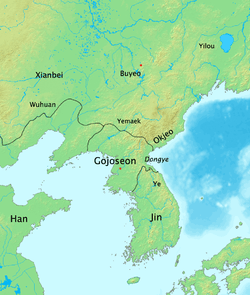 Korea 108 BC
Korea 108 BC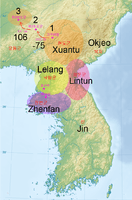 The Four Commanderies of Han, 107 BC
The Four Commanderies of Han, 107 BC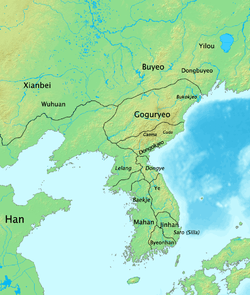 Korea in 1 AD
Korea in 1 AD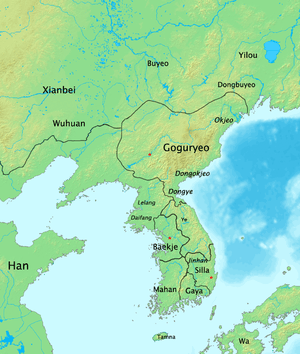 Korea 204 AD
Korea 204 AD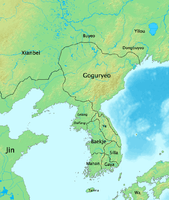 Korea in 300 AD
Korea in 300 AD Korea in 315 AD
Korea in 315 AD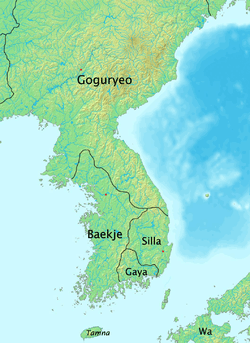 Korea in 375 AD
Korea in 375 AD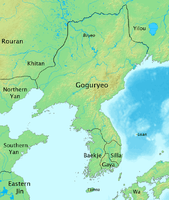 Korea in 410 AD
Korea in 410 AD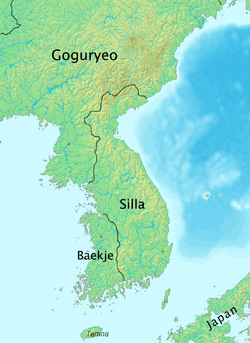 Korea in 576 AD
Korea in 576 AD Goguryeo–Tang War (645–668)
Goguryeo–Tang War (645–668)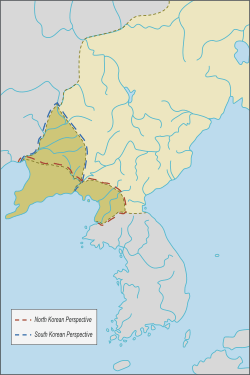 Little Goguryeo (699–820)
Little Goguryeo (699–820)_(4261052261).jpg) Unified Silla and Balhae in the 8th century AD
Unified Silla and Balhae in the 8th century AD Balhae in 800 AD
Balhae in 800 AD Balhae in 830 AD
Balhae in 830 AD Liao dynasty (907–1125)
Liao dynasty (907–1125)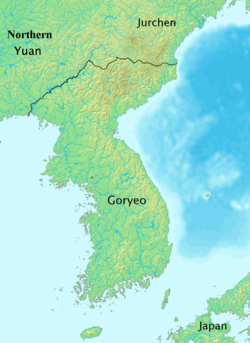 Goryeo in 1374
Goryeo in 1374_(4261814162).jpg) Joseon (15th century)
Joseon (15th century)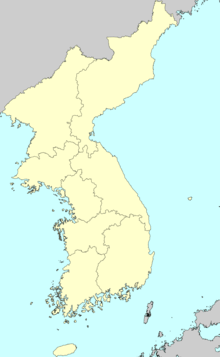
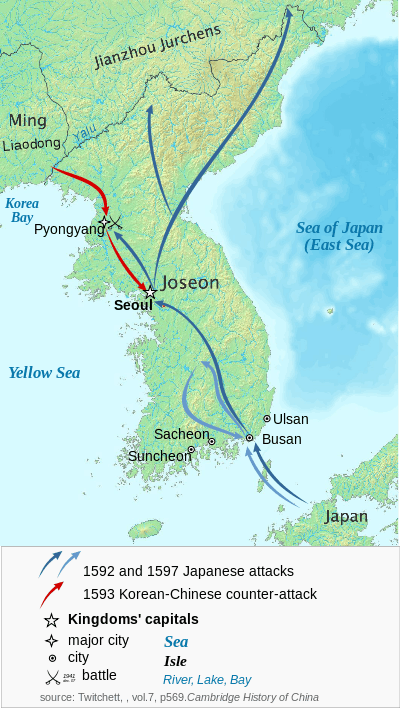
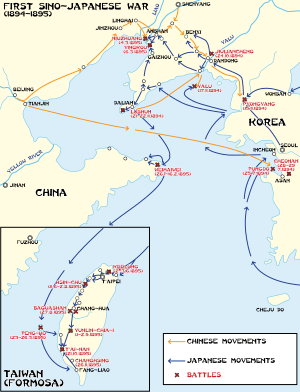 First Sino-Japanese War (25 July 1894 – 17 April 1895)
First Sino-Japanese War (25 July 1894 – 17 April 1895).svg.png) Empire of Japan (1868–1947)
Empire of Japan (1868–1947) Korean War May 1950
Korean War May 1950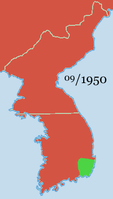 Korean War September 1950
Korean War September 1950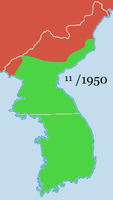 Korean War November 1950
Korean War November 1950 Korean War January 1951
Korean War January 1951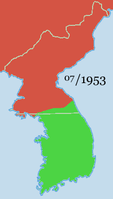 Korean War July 1953
Korean War July 1953